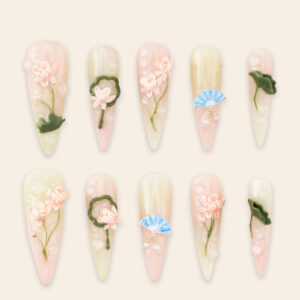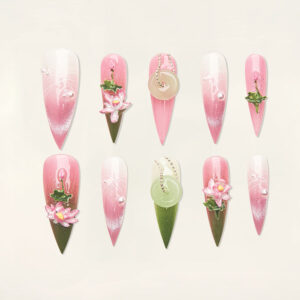Why Learn to Use Electric Nail File Properly
An electric nail file, or nail drill, can transform your manicure routine—if you know how to use it correctly. Whether you’re working on gel polish, acrylic extensions, or natural nails, using a drill saves time and delivers salon-quality results. But without the right technique, it’s easy to damage your nails or cuticles. This guide explores how to use an electric nail file effectively, including tips on how to use electric nail file for optimal results.
This guide will show you how to use an electric nail file safely, efficiently, and like a professional—even if you’re just starting out, you’ll learn how to use electric nail file with confidence and precision.
![How to Use Electric Nail File Like a Pro [2025 Guide] 1 How to use electric nail file like a pro](https://cdn.yabe.global/wp-content/uploads/2025/05/2148766615-edited.jpg)
What You’ll Need Before You Start Using Electric Nail File
To get the best results while using an electric nail file, gather the right tools to ensure you master how to use electric nail file effectively:
- Electric nail file/drill machine (with adjustable RPM).
- Drill bits: sanding bands, cone, barrel, needle, etc.
- Cuticle pusher or trimmer.
- Dust brush and cotton pads.
- Isopropyl alcohol (70%) for cleaning.
- Safety mask and eye protection (optional but recommended).
- Cuticle oil for post-filing care.
Understanding Drill Bit Types and Their Functions
Different bits serve different purposes. Here’s a quick guide:
![How to Use Electric Nail File Like a Pro [2025 Guide] 2 How to use an electric nail file like a pro](https://cdn.yabe.global/wp-content/uploads/2025/05/image-102-1024x538.png)
| Bit Type | Use | Best For |
|---|---|---|
| Mandrel + Sanding bands | Prepping and shaping | Beginners, natural nails |
| Barrel bit | Surface shaping | Acrylics and gels |
| Cone bit | Cuticle and sidewall cleanup | Natural nails |
| Needle bit | Under-nail cleaning and edge detailing | Nail extensions |
| Safety bit | Smooth surface work with rounded tip | Beginner filing and gel removal |
Grit Types:
- Fine grit (Red): Natural nails, buffing.
- Medium grit (Blue): Light shaping.
- Coarse grit (Green/Black): Acrylic removal, heavy filing.
![How to Use Electric Nail File Like a Pro [2025 Guide] 3 How to use electric nail file like a pro](https://cdn.yabe.global/wp-content/uploads/2025/05/Step-by-Step-Guide-How-to-Use-an-Electric-Nail-File-Like-a-Pro-683x1024.jpg)
Step-by-Step Guide: How to Use an Electric Nail File Like a Pro
Step 1: Clean and Prep the Nails
Start with freshly washed hands. Remove any old polish and use a lint-free wipe with 70% isopropyl alcohol to cleanse the nail surface. Gently push back the cuticles with a wooden or metal cuticle pusher.
Step 2: Choose the Right Bit
Select a fine or medium sanding band for beginners, or a safety bit if you’re working on gel polish. Insert the bit into the handpiece until secure.
Step 3: Set the Right Speed (RPM)
- Natural nails: 5,000–10,000 RPM
- Gel removal: 10,000–15,000 RPM
- Acrylics: 20,000–30,000 RPM
Always start low and increase only if needed.
Step 4: Hold the Drill Like a Pencil
Grip the handpiece with your dominant hand, resting your pinky finger on the client’s hand or your own for balance. This improves precision and control.
Step 5: File With Gentle, Consistent Motion
Move the bit in smooth, side-to-side motions across the nail surface. Never keep it in one spot longer than 2 seconds to avoid heat spikes.
- Direction: Use forward mode if you’re right-handed; reverse for left-handed users.
- Angle: Keep the bit at a 45-degree angle—not flat on the nail.
Step 6: Refine and Smooth
Once shaping is done:
- Use a cone or safety bit for cuticle area cleanup
- Switch to a buffing bit or soft sanding band to smooth the surface
Step 7: Clean and Moisturize
Dust off debris with a nail brush. Wipe nails again with alcohol, then apply cuticle oil and hand cream.
Pro Tips for Precision and Safety
- Always sanitize your bits before and after use
- Never apply too much pressure—let the bit do the work
- Use a dust collector or wear a mask when filing acrylic or gel
- Switch out worn bits—they reduce performance and increase risk
- Practice on fake tips before using on your own nails
Common Mistakes Beginners Make (And How to Avoid Them)
| Mistake | Why It’s Risky | What to Do Instead |
|---|---|---|
| Holding the drill at the wrong angle | Can gouge the nail plate | Keep a 45° angle and a steady hand |
| Using high speed too soon | Causes heat, damage, discomfort | Start with low RPM and work up |
| Filing in the same spot | Generates heat and weakens the nail | Keep moving in short, even strokes |
| Skipping cuticle work | Leads to polish lifting or infection | Use a cone or cuticle pusher gently |
| Not cleaning bits | Can spread bacteria or fungus | Clean with alcohol or disinfectant brush |
![How to Use Electric Nail File Like a Pro [2025 Guide] 4 How to use electric nail file like a pro [2025 guide]](https://cdn.yabe.global/wp-content/uploads/2025/05/Common-Mistakes-Beginners-Make-1024x683.jpg)
Electric Nail File for Acrylics, Gel, and Natural Nails
- For Natural Nails: Use fine-grit bands or ceramic safety bits, low RPM, and a light touch. Never over-file the nail plate.
- For Gel Polish: Use a medium grit barrel or safety bit, around 10,000–15,000 RPM. Thin out layers before soaking off with acetone.
- For Acrylics: Use coarse bits, higher RPM (20,000–30,000), and strong torque. Don’t dig—glide smoothly instead.
Video Tutorial: Watch the Process in Action
Sometimes seeing is better than reading. Here are a few trusted YouTube tutorials that demonstrate proper electric nail file techniques:
💡 Tip: Practice along with a video using a training hand or nail tips before working on real nails.
FAQs: How to Use Electric Nail Files
-
What speed should I use for different materials?
+ Natural nails: 5,000–10,000 RPM
+ Gel polish: 10,000–15,000 RPM
+ Acrylic removal: 20,000–30,000 RPM -
Can I use an electric file on natural nails?
Yes, but always use fine grit bits and stay under 10,000 RPM.
-
How do I clean the drill bits?
Use a bit brush, soak in 70% alcohol, or use an ultrasonic cleaner. Let dry completely before reusing.
-
What’s the best direction for filing?
Use forward for right-handed users and reverse for left-handed. Most drills have a switch for this.
-
Is it safe for beginners?
Absolutely! Start slow, use safety bits, and avoid over-filing. Always prep and clean properly.
Conclusion
Using an electric nail file isn’t just for professionals anymore. With a bit of practice and the right safety habits, you can master this tool like a pro—saving time and elevating your at-home nail game.
Whether you’re filing down gel, shaping acrylics, or buffing natural nails, remember:
- Start low and go slow
- Use the right bit and RPM for each task
- Clean your tools regularly
- Practice on tips before working on yourself or others




